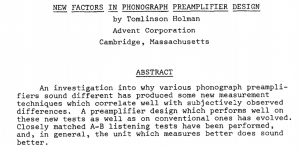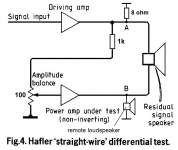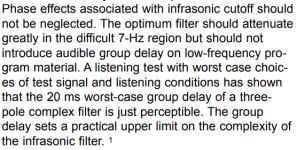Hi Hans
And your point is?
BTW: Where do you get that delay from? Is it a normal phase shift?
S
My point is that speed distortion does not exist.
Read my above postings.
Result from subtracting In from Out has no meaning when the GD is not constant over the frequency band that the input signal has.
So a sudden stop and start will never fulfill that condition and will show something something meaningless.
Hans
My point is that speed distortion does not exist.
Read my above postings.
Result from subtracting In from Out has no meaning when the GD is not constant over the frequency band that the input signal has.
So a sudden stop and start will never fulfill that condition and will show something something meaningless.
Hans
Good, then we agree, but in my opinion your posts and proof was a bit cluphsy.
That was the reason for my question.
Stein
At a frequency lower or higher than 10Khz, say Z the amp will have a different GD say Y so when subtracting in &out, you will get sin(2pi*Z*t)-sin(2pi*Z*t+Phase(X-Y)) which will result in a new sine whose amplitude depends on the phase difference caused by X-Y for that frequency Z.
Hans
So does this does not create new frequencies then?
Jan
These frequencies are already present in the original signal at the input.
A gated sine wave is the product of a sinewave and a square pulse. Spectrum of sine wave is 2 spikes at +/- frequency ; spectrum of square pulse is sin(x)/x. Time domain multiplication is frequency domain convolution, so the spectrum of the gated sine is sin(x)/x shifted in frequency. It contains frequencies both above and below the sine wave frequency, there are bumps all over the place.
It is not possible to make a gated sine with a single frequency in its spectrum, because then it would no longer be gated, it would be a static sine signal.
The amp applies frequency-dependent phase shift to this signal, so all the frequencies at the input get a different delay at the output. When substracting the input signal with delay, only one frequency is nulled, the others are not. Playing with the microcap file attached above, this is apparent: the output "distortion" depends on the order and cutoff of the lowpass filter applied to the gated sine, which lets through different amounts of different frequencies. It is possible to use a bandpass too, which gives different results.
This will make the leading edge look distorted. It is not nonlinear distortion, because the process is linear. No new frequencies are added, only existing frequencies are phase-shifted. But is the change in shape of the signal audible? Would have to look into psychoacoustics.
A gated sine wave is the product of a sinewave and a square pulse. Spectrum of sine wave is 2 spikes at +/- frequency ; spectrum of square pulse is sin(x)/x. Time domain multiplication is frequency domain convolution, so the spectrum of the gated sine is sin(x)/x shifted in frequency. It contains frequencies both above and below the sine wave frequency, there are bumps all over the place.
It is not possible to make a gated sine with a single frequency in its spectrum, because then it would no longer be gated, it would be a static sine signal.
The amp applies frequency-dependent phase shift to this signal, so all the frequencies at the input get a different delay at the output. When substracting the input signal with delay, only one frequency is nulled, the others are not. Playing with the microcap file attached above, this is apparent: the output "distortion" depends on the order and cutoff of the lowpass filter applied to the gated sine, which lets through different amounts of different frequencies. It is possible to use a bandpass too, which gives different results.
This will make the leading edge look distorted. It is not nonlinear distortion, because the process is linear. No new frequencies are added, only existing frequencies are phase-shifted. But is the change in shape of the signal audible? Would have to look into psychoacoustics.
So does this does not create new frequencies then?
Jan
No, as PeuFeu also mentions, no new frequencies are created by phase shifts.
But the whole point is that we are looking at the wrong side of a supposed problem.
When we use distortion the way it should be used, it would have to be something that we can hear and then find ways how to measure it.
So what can we hear when phase shifts are applied ?
Tests have indicated that up to 3Khz our hearing threshold is between 180 and 360 degrees phase shifts deviation from linear phase (or GD) and that above 5Khz we cannot hear any phase shift.
Using this information, we should talk about a maximum allowable phase shift from linear phase in the audio band, or translated in time: a maximum deviation from a constant GD that goes from 25msec at 20Hz to 165usec at 3Khz.
And of course it would be good practice to set a goal for allowable deviations 10 times lower than that and extend the frequency range to 100Khz.
GD itself is nothing but a relative time delay that does not influence sound perception in any way, so mentioning as Petr does that GD should be in the low nsec to prevent so called speed errors, has no meaning at all.
Hans
Last edited:
So does this does not create new frequencies then?
Jan
Jan,
Added to the above; phase shifts caused by a first order all pass filter, as was used in my sim, is a linear proces. There are no multiplications taking place that are needed to create new frequencies.
Hans
GD itself is nothing but a relative time delay that does not influence sound perception in any way, so mentioning as Petr does that GD should be in the low nsec to prevent so called speed errors, has no meaning at all.
If group delay is constant with output current and amplitude.
Flanagan, Moore and Stone studied the problem, results were published in the JAES in 2005 (if memory serves). They concluded that under the most demanding/sensitive conditions (headphones) GD needs to be well over 1mS to be audible, much more at higher frequencies. About 6 to 7 orders of magnitude higher than what out dear troll preaches here.
Discrimination of Group Delay in Clicklike Signals Presented via Headphones and Loudspeakers
Document Thumbnail
Thresholds were measured for the discrimination of a click reference stimulus from a similar stimulus with a group delay in a specific frequency region, introduced using an all-pass filter. For headphone presentation the thresholds were about 1.6 ms, were independent of the center frequency of the delayed region (1, 2, or 4 kHz), and did not differ significantly for monaural and binaural listening. For presentation via loudspeakers in a low-reverberation room the thresholds were only slightly higher than with headphones and did not differ significantly for distributed-mode loudspeakers (DMLs) and cone loudspeakers. For presentation via the same loudspeakers in a reverberant room the thresholds were larger than the corresponding thresholds measured in the low-reverberation room, and this effect increased with decreasing center frequency for both loudspeaker types. For monaural listening the thresholds for discriminating group delay were significantly larger for the DML than for the cone loudspeaker, probably due to the higher ratio of reverberant-to-direct sound for the former, associated with its lower directivity. However, for binaural listening the difference between DML and cone loudspeakers became nonsignificant.
Authors: Flanagan, Sheila; Moore, Brian C. J.; Stone, Michael A.
Affiliation: University of Cambridge, Cambridge, UK
JAES Volume 53 Issue 7/8 pp. 593-611; July 2005 Permalink
Publication Date: July 15, 2005 Import into BibTeX
For those who have access.
Jan
Document Thumbnail
Thresholds were measured for the discrimination of a click reference stimulus from a similar stimulus with a group delay in a specific frequency region, introduced using an all-pass filter. For headphone presentation the thresholds were about 1.6 ms, were independent of the center frequency of the delayed region (1, 2, or 4 kHz), and did not differ significantly for monaural and binaural listening. For presentation via loudspeakers in a low-reverberation room the thresholds were only slightly higher than with headphones and did not differ significantly for distributed-mode loudspeakers (DMLs) and cone loudspeakers. For presentation via the same loudspeakers in a reverberant room the thresholds were larger than the corresponding thresholds measured in the low-reverberation room, and this effect increased with decreasing center frequency for both loudspeaker types. For monaural listening the thresholds for discriminating group delay were significantly larger for the DML than for the cone loudspeaker, probably due to the higher ratio of reverberant-to-direct sound for the former, associated with its lower directivity. However, for binaural listening the difference between DML and cone loudspeakers became nonsignificant.
Authors: Flanagan, Sheila; Moore, Brian C. J.; Stone, Michael A.
Affiliation: University of Cambridge, Cambridge, UK
JAES Volume 53 Issue 7/8 pp. 593-611; July 2005 Permalink
Publication Date: July 15, 2005 Import into BibTeX
For those who have access.
Jan
Last edited:
Who still needs Wikipedia with Syn08 in the background 😀
On top of that, in oct 1975 Tomlinson Holman presented to the AES that a rumble filter should have a delay of 25msec max at 20Hz.
That’s how I came to the interpolated threshold of 180 to 360 degrees additional phase shift from 20Hz up to 3Khz.
Hans
On top of that, in oct 1975 Tomlinson Holman presented to the AES that a rumble filter should have a delay of 25msec max at 20Hz.
That’s how I came to the interpolated threshold of 180 to 360 degrees additional phase shift from 20Hz up to 3Khz.
Hans
In that article IIRC he shows on one of the graphs the DIN standard which for below 100 Hz showed GD of up to 20 ms was inaudible - obviously lower at higher frequency.
I was agonizing over GD in the rumble filter of the design in AX - after reading that reference, I came to the conclusion it was a non-issue.
I was agonizing over GD in the rumble filter of the design in AX - after reading that reference, I came to the conclusion it was a non-issue.
Hans, unlike you on this issue, I completely agree with David Hafler
Hafler XL-280 power amplifier | Stereophile.com
“An attenuation of 70dB produces a signal less than one three-thousandth the amplitude of the original (0.0003 of the original), therefore distortion at this level, just 0.03%, would be a very respectable figure by anyone's accounting.”
Note.
the test measures vector errors, not harmonic distortion. And vector errors, even with a perfectly stable audio band delay (tPD), are inversely proportional to period:
a = 2π (tPD) / T
a - the amplitude of the vector error
T - period of the test signal (100 μs for a frequency of 10 kHz)
-70 dB means tPD is calculated to be very low, around 10 ns
“Quad also introduced phase and amplitude compensation in the straight-wire path to improve the null by making the amplifier and the wire more alike. This alteration—"bending," if you will—of the straight wire was done on the assumption that phase and amplitude errors are inaudible. I prefer to make no assumptions as to audibility, thus making the test more stringent.”
“The question of phase shift and time delay from input to output has been raised by several readers. That difference between input and output will prevent a good "null" and will produce residual sound. Obviously, a constant time delay (uniform across the band) will not produce an adverse audible effect. However, the residual from phase shift might mask other distortion components in the SWDT. I prefer to see, therefore, an amplifier design which is sufficiently broadband to minimize time delay in the audio band.”
«Although there is high correlation between a deep "null" and good (accurate) sound»
«If the residual "null" is inaudible, the conclusion that the amplifier is accurate is unequivocal. »
Hafler XL-280 power amplifier | Stereophile.com
“An attenuation of 70dB produces a signal less than one three-thousandth the amplitude of the original (0.0003 of the original), therefore distortion at this level, just 0.03%, would be a very respectable figure by anyone's accounting.”
Note.
the test measures vector errors, not harmonic distortion. And vector errors, even with a perfectly stable audio band delay (tPD), are inversely proportional to period:
a = 2π (tPD) / T
a - the amplitude of the vector error
T - period of the test signal (100 μs for a frequency of 10 kHz)
-70 dB means tPD is calculated to be very low, around 10 ns
“Quad also introduced phase and amplitude compensation in the straight-wire path to improve the null by making the amplifier and the wire more alike. This alteration—"bending," if you will—of the straight wire was done on the assumption that phase and amplitude errors are inaudible. I prefer to make no assumptions as to audibility, thus making the test more stringent.”
“The question of phase shift and time delay from input to output has been raised by several readers. That difference between input and output will prevent a good "null" and will produce residual sound. Obviously, a constant time delay (uniform across the band) will not produce an adverse audible effect. However, the residual from phase shift might mask other distortion components in the SWDT. I prefer to see, therefore, an amplifier design which is sufficiently broadband to minimize time delay in the audio band.”
«Although there is high correlation between a deep "null" and good (accurate) sound»
«If the residual "null" is inaudible, the conclusion that the amplifier is accurate is unequivocal. »
Attachments
Last edited:
“However, the residual from phase shift might mask other distortion components in the SWDT. I prefer to see, therefore, an amplifier design which is sufficiently broadband to minimize time delay in the audio band.”
So, Mr Hafler says:
1 - Residual phase shift may mask the distortion measured;
2 - He therefor prefers low phase shift and low time delay in order to be able to measure the distortion.
So the whole stuff about phase shift and group delay is only needed to 'repair' this test method. Because they had nothing better at the time.
Of course, as we all know, these days a good sound card with free REW works much, much better and doesn't have these limitations of the Hafler test ...
Jan
So, Mr Hafler says:
1 - Residual phase shift may mask the distortion measured;
2 - He therefor prefers low phase shift and low time delay in order to be able to measure the distortion.
So the whole stuff about phase shift and group delay is only needed to 'repair' this test method. Because they had nothing better at the time.
Of course, as we all know, these days a good sound card with free REW works much, much better and doesn't have these limitations of the Hafler test ...
Jan
Yes.
Which is precisely why all my phone preamp I designed in the last years have at the output an optional 3rd order Sallen Key HPF, tuned to some 10-12Hz. Myself, I have to admit I am having a subjective issue with woofer cones flapping 😀.
the Hafler test measures vector errors, not harmonic distortion.
Sorry, but you are firmly captured in a Hafler religion.
As long as this takes, no further discussions seems possible.
Succes,
Hans
It is pointless to continue further dialogue
no further discussions seems possible.
You guys seem to be in violent agreement.
Poor me, I will never find out WTF are "vector errors", or at least the right English language translation.
Last edited:
- Home
- Amplifiers
- Solid State
- Musings on amp design... a thread split


